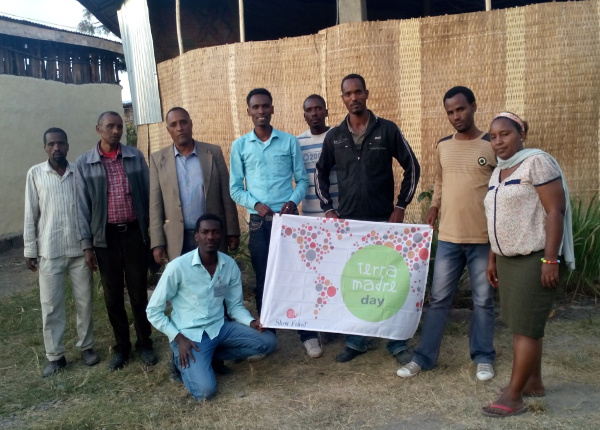Permaculture Scotland Gathering
This June, Angus and Krysia attended the Permaculture Scotland Gathering in Fife. It was well organised and full of friendly people.
Graham Bell gave an excellent talk on abundance. He provided much information about the forest garden at Garden Cottage (“all growers are researchers”). The latest figures indicate that yields are around 16 tonnes per hectare, comparing favourably with the nearby "industrial" agriculture in the Tweed Valley – at best 6 te/ha. Graham shared many insights and several historical facts. (Bangladesh planted one million trees in a day recently, showing what can be achieved). With his depth of experience and his eloquence, it is easy to see why Graham is so highly respected as an international permaculture teacher.
| No pictures of this year's event, but here's one from 20 years ago - Graham Bell leads a tour of permaculture projects on the Scottish Borders, 1998 - photo by Angus Soutar |
Open Days at Garden Cottage are advertised on their website where you can also find much, much more.
We attended a useful workshop from David Stutchfield (St Andrews University) about adapting to climate change in Scotland. Predictions state that, by 2050, Dundee will have the same climate as the Isle of Wight does now (maybe marmalade production will come back there one day?). Rainfall in Scotland will become heavier so the risk of flood damage will increase. The Scottish Government has allocated money to engage local communities in local planning. The “work” part of the workshop involved “playing” with the materials developed so far, which stimulated much discussion about design of the built environment, the need for more (permaculture) planting, a discussion about “managed retreat” and several other issues.
 |
|---|
| The materials seem really useful in stimulating discussion about localisation in general and they are available through the excellent Adaptation Scotland website. David also has an impressive collection of predictions for climate change in Scotland. |
 |
Pittarthie Farm, near St Andrews, Fife
The 2018 Permaculture Scotland Gathering's programme of site visits gave us a some pointers for the future of agriculture, most prominently at Pittarthie Farm. Its 400 acres have been in the Bowden-Smith family for 500 years and the family has a land stewardship approach common to many small farmers. Although it is a mixed farm run on conventional lines, there are many features in common with permaculture approach. A total of 70 acres has been dedicated to water and nutrient management. There are extensive ponds and reedbeds and a road that acts as a swale. Patrick Bowden-Smith explains that the 70 acres are managed with small-scale “enterprise stacking”. Tens of thousands of trees have been planted and the farm boasts its own sawmill. While providing abundant biodiversity and capturing fertiliser run-off, much of the land is grazed by Shetland sheep who are not too fussy about their diet.
| Patrick Bowden-Smith shows some of the main features of water management on Pittarthie Farm |
Although Patrick farms 150 acres organically, he views “Organic” as totally unsustainable: energy inputs can be higher than conventional farming and there is no appreciable improvement in soil quality. His stimulating and robust hosting of the tour would have been most enjoyable, had it not been for some distressing tales about the impact of the Scottish bureaucracy on small farmers. There is little leeway for farmers moving towards a “whole systems” approach.
| This productive wetland area, amongst other things, functions to capture nutrient run-off that would otherwise leave the farm. |
 |
From our Ethiopian correspondent
Asmelash Dagne Daiko
During my international travelling experience to present the successes and challenges of my permaculture projects, I always keep connecting people and develop international permaculture community. One of the best example was in 2015. I met Zoe Rozar from Mauritius in Turin, Italy. She was attending the same conference where I was invited to share my experience. She told me that she was doing a diploma in permaculture with Northern School of Permaculture and I asked her if she can connect me to them. Luckily, me and Northern School managed to get connected and as a result we are working together. We are doing a good job in spreading permaculture across the globe. I managed to connect the Northern School with my teacher veteran Zimbabwean trainer and consultant Tichafa Makovere. Connections are moving at international level and play a great role in developing international permaculture community.
I am learning a lot from Northern School of Permaculture but not paying back in cash, just sharing my African experience for their PDC's to be used as educational tools. We benefit from each other. Therefore I learn from my elders and through my experience I have already started to “pay forward” by teaching and developing young permaculture experts who will take over the networking and building the permaculture community in the future.
 |
|---|
| One of the training groups for "10,000 gardens in Africa" project coordinators - networking and experience sharing |
 |